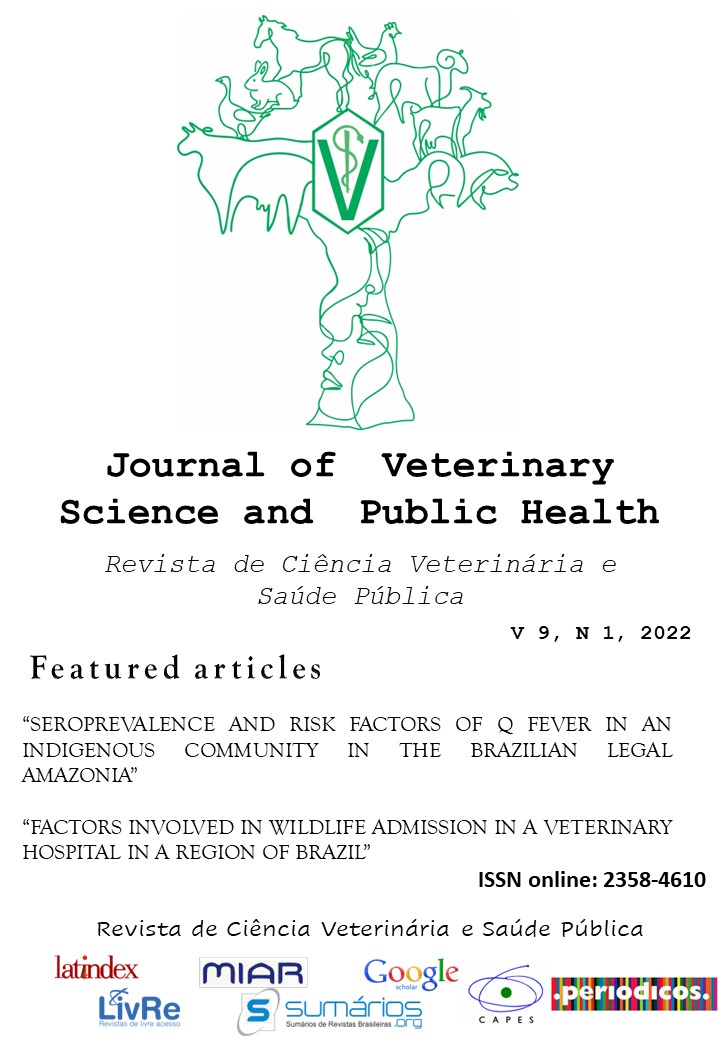QUALITATIVE EVALUATION OF THE MEDIAL ROTATION OF THE PROXIMAL TIBIA AFTER HIP LUXATION. AN ATTEMPT TO PROVE THE INFLUENCE OF THE POSITIONING OF THE COXOFEMORAL JOINT IN THE ETIOPATHOGENY OF MEDIAL PATELLAR LUXATION IN DOGS
Abstract
The objective was to evaluate the degree of medial tibial rotation after hip luxation to prove the influence of the position of the hip joint on the etiopathogenesis of medial patellar luxation in dogs. Qualitative analyzes were performed on ten dog cadavers. The observation of medial rotation and loosening of the ligament was made by clinical analyzes through knee flexion and extension with slight medial rotation, mimicking the anatomical movement of the knee when the animal touches the ground. The same analyzes were performed with the luxated hip joint in the craniodorsally and caudoventrally position. There was a great difference in the looseness of the patellar ligament, especially in limb hyperextension, when there was dislocation of the hip. When compared to the normal tension of the patellar ligament, there was greater laxity of the patellar ligament when the femur was craniodorsally dislocated and slight laxity of the patellar ligament when the femur was dislocated caudoventrally. As for the internal rotation of the tibia, during the knee flexion and extension movement, also in comparison with the preserved hip joint, there was greater medial rotation of the tibia in the craniodorsally dislocation of the femur and little medial rotation of the tibia in the caudoventrally dislocation of the femur. It is concluded that the poor conformation of the hip joint directly influences the tension of the quadriceps muscle and consequently in the patellar ligament, favoring the internal rotation of the proximal tibia, acting as a possible predisposing factor for medial patellar dislocations.
Downloads
References
DECAMP, C.E.; JOHNSTON, S.A.; DÉJARDIN, L.M.; SCHAEFER, S.L. Handbook of small animal orthopedics and fracture repair. 5st ed. St. Louis: Elsevier; 2016. 877p.
DYCE, K.M.; SACK, W.O.; WENSEING, C.J.G. Tratado de Anatomia Veterinária. 4st ed. Rio de Janeiro: Elsevier; 2010. 856p.
FOSSUM, T.W. Small animal surgery textbook. 4 st ed. St Louis: Elsevier Health Sciences; 2013. 1775p.
KONIG, H.E. e LIEBICH, H. Anatomia Dos Animais Domésticos - Textos e Atlas Colorido. 6st ed. São Paulo: Artmed; 2016. 824p.
MORAES, P.C. e CRIVELLENTI, L.Z. Neurologia e distúrbios musculoesqueléticos. In: CRIVELLENTI, L.Z. e BORIN-CRIVELLENTI, S. Casos de rotina em medicina veterinária de pequenos animais. São Paulo: Medvet; 2012. p. 305-354.
NUNAMAKER, D.M.; BIERY, DN.; NEWTON, C.D. Femoral neck anteversion in the dog. It’s radiographic measurement. Journal of American Veterinary Radiology Society, v.14, p.45-47, 1973.
PARDI, M.C.; DOS SANTOS, I.F.; DE SOUZA, E.R.; PARDI, H.S. Ciência, Higiene e Tecnologia da Carne - Vol. 1. 1st ed. Goiania: Editora Universitária (Eduff); 1993. 77p.
PÊREZ, P. e LAFUENTE, P. Management of medial patellar luxation in dogs: what you need to know. Veterinary Ireland Journal, v.4, p.634-640, 2014.
ROUSH, J.K. Canine patellar luxation. Veterinary Clinics of North America: Small Animal Practice, v.23, p.855-868, 1993.
SOUZA, M.M.D.; RAHAL, S.C.; OTONI, C.C.; MORTARI, A.C.; LORENA, S.E.R.S. Luxação de patela em cães: estudo retrospectivo. Arquivo Brasileiro de Medicina Veterinária e Zootecnia, v.61(2), p.523-526, 2009.
TOBIAS, N. e JOHNSTON, S.A. Veterinary Surgery Small Animal. St Louis: Elsevier Health Sciences; 2012. 2777p.
TORRES, B.B.J.; MUZZI, L.A.L.; MESQUITA, L.R. Ruptura do ligamento cruzado cranial – revisão. Clínica Veterinária, v.17(100), p.100-112, 2012.
WEIGEL, J.P. e WASSERMAN, J.F. Biomechanics of the normal and abnormal hip joint. Veterinary Clinics of North America: Small Animal Practice, v.22(3), p.513-528, 1992.








